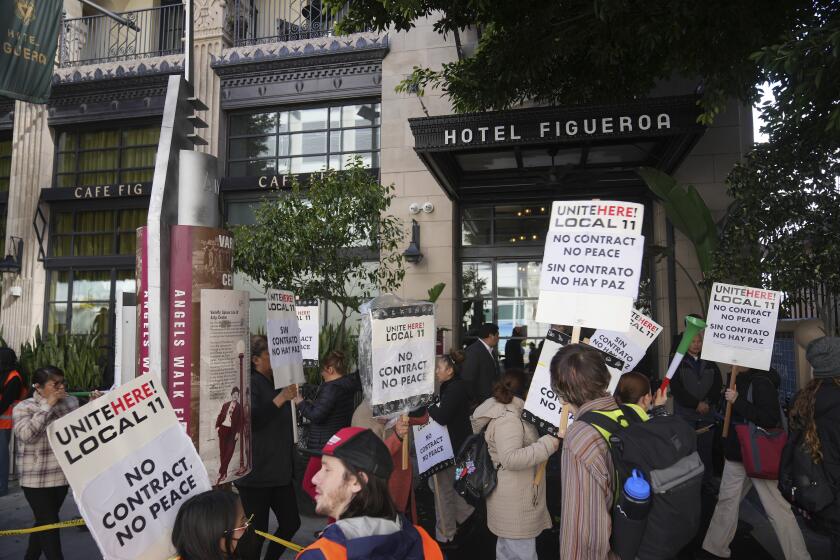Stocks wrap up best year since 2003
The U.S. stock market on Friday closed out its best year since 2003 as Wall Street showed increasing faith that the slowing economy was on track for the hoped-for “soft landing.”
The Dow Jones industrial average gained 1,745 points, or 16.3%, for the year -- a sharp turnaround after the blue-chip index lost 0.6% in 2005.
The Dow eased 38.37 points, or 0.3%, to 12,463.15 on Friday amid a modest bout of selling on the year’s final trading day. The index had reached a record closing high of 12,510.57 on Wednesday.
Most broader U.S. market indexes joined the Dow in posting double-digit gains for 2006. The Standard & Poor’s 500 was up 13.6%, and the Russell 2,000 small-stock index surged 17%.
The technology-dominated Nasdaq composite was a relative laggard, up 9.5% for the year.
For a fourth straight year, many foreign stock markets far outran Wall Street, reflecting robust economies overseas.
After a rocky first half of the year for markets -- including a steep sell-off from mid-May to mid-June -- the stars aligned in the second half: The Federal Reserve stopped raising short-term interest rates, long-term rates tumbled, oil prices declined and no major geopolitical or natural disasters befell the economy.
“In [Fed] policymakers’ eyes, everything went perfectly,” said Mickey Levy, chief economist at Bank of America in New York.
Most important, despite a sharp slowdown in housing and auto sales, the U.S. economy overall proved resilient. That has boosted optimism about a soft landing, meaning a slowdown in growth that is enough to restrain inflation but not enough to seriously erode the corporate earnings growth that supports stock prices.
The U.S. outlook has been helped by continuing strength in key foreign economies. Business confidence is at a two-year high in Japan and a record high in Germany, according to recent surveys. China’s booming economy is underpinning Asian growth.
“You have a global economy that looks like it’s going to be pretty good for businesses,” said Bill Fries, a stock mutual fund manager at Thornburg Investment Management in Santa Fe, N.M.
Operating earnings of the S&P; 500 companies are estimated to have risen 14.9% this year from 2005, according to S&P; analysts. Through the third quarter, earnings had risen at a double-digit year-over-year percentage rate for 18 straight quarters, a record streak.
Most Wall Street pros are expecting a slowdown in earnings gains in 2007, consistent with the soft-landing scenario. S&P; is projecting a 9.5% rise in blue-chip companies’ profit next year.
Bullish analysts say U.S. stocks can keep advancing despite slower profit growth because share prices are playing catch-up to the rapid earnings growth of the last few years.
In 2005 the S&P; 500 index edged up just 3%, even as earnings of the companies in the index jumped 14% from the previous year.
Doug Sandler, chief equity strategist at Wachovia Securities in Richmond, Va., said investors this year rediscovered the appeal of shares of big-name companies in part because the stocks were relatively inexpensive compared with underlying earnings.
“Most of the really good stuff isn’t that expensive,” he said of name-brand shares.
Telecommunications giant AT&T; surged 46% for the year, Walt Disney rose 43% and Exxon Mobil jumped 36%. All three are members of the Dow.
The 30-stock Dow’s gain this year was its biggest since it rallied 25.3% in 2003, the first year of the current bull market. On Oct. 3 the Dow finally surpassed the 11,722.98 mark, its peak at the end of the last bull market in 2000.
Investors also continued to snap up stocks of smaller companies, which have led the market in this decade. The Russell 2,000 index plunged 14% in the spring sell-off, then roared back. It hit a record high Wednesday.
A torrent of merger deals and buyouts led by private equity investors this year has reinforced the idea that shares are attractively priced.
The buyout wave, powered by borrowed money, is a sign that financial conditions remain fairly easy despite two years of credit tightening by the Fed, analysts say.
“The Fed took away the accommodation but did not move to restrictive mode,” Levy said.
But the path of interest rates remains one of the crucial questions of the new year.
Fed Chairman Ben S. Bernanke has warned that the Fed might have to raise its key short-term rate from the current 5.25% if inflation pressures don’t subside further.
The European Central Bank has signaled that it isn’t finished raising rates, and the Bank of Japan also is expected to tighten credit in 2007 after two such moves this year.
Long-term bond yields in the U.S. and Europe have rebounded in recent weeks on concerns about central banks’ plans. The 10-year U.S. Treasury note ended Friday at 4.70%, up from a 10-month low of 4.42% on Dec. 4.
The plunge in stock markets worldwide in spring was triggered in part by rising interest rates.
Many analysts say stocks are overdue for a pullback after their powerful rallies since midyear.
Some individual investors are taking those warnings to heart.
Marc Hoffman, an investor in Louisville, Ky., who is president of the Midwest Baseball Academy, said his reaction to the market’s big gains was more caution than enthusiasm.
“The market has done nothing but go up in the past six months,” he said. “I wouldn’t be surprised if it dropped 5% or 10%.
“I don’t intend to take any money off the table, but I might set some money aside and wait to invest it until there’s a dip,” Hoffman said. “Right now, I’d rather put money to work in stages, rather than plopping a big pile of cash in all at once.”
Buying the spring dip proved highly profitable for investors who had the courage to step up.
The Mexican stock market plunged 24% from mid-May to mid-June but then rocketed in the second half to new highs. The market rose 48.6% for the year.
Russia’s stock market soared 71% for the year. The Hong Kong market shot up 34%.
U.S. investors have been big buyers of foreign stocks for the last two years, lured by surging prices and by the weak dollar. A falling dollar means stocks denominated in stronger currencies automatically are worth more to American investors when translated into dollars.
Joset Wright, an executive recruiter in Chicago, said foreign stocks made up about one-quarter of her total stock portfolio. She said she planned to tweak her investment mix to put more overseas next year because she expected foreign markets would continue to soar.
Among the highlights on the last trading day of the year:
* The S&P; 500 slipped 6.43 points, or 0.4%, to 1,418.30. The Nasdaq fell 10.28 points, or 0.4%, to 2,415.29.
* Crude-oil futures rose 52 cents a barrel to $61.05 on the New York Mercantile Exchange. That’s just a penny more than the closing price on the last trading day of 2005.
* Gold ended at $635.20 an ounce, up $1.10 for the day and up $118.10, or 22%, for the year.
kathy.kristof@latimes.com
*
(BEGIN TEXT OF INFOBOX)
Bull run
--
How key U.S. and foreign stock market indexes fared in 2006.
*--* Country/index Pctg. change China/Shanghai B +109.8% Mexico/IPC +48.6% India/Sensex +46.7% Brazil/Bovespa +32.9% Germany/DAX +22.0% Australia/All Ordinaries +20.0% U.S./Dow industrials +16.3% U.S./S&P; 500 +13.6% Britain/FTSE 100 +10.7% U.S./Nasdaq composite +9.5% Japan/Nikkei 225 +6.9%
*--*
--
Note: Change measured in local currencies.
Source: Bloomberg News
More to Read
Inside the business of entertainment
The Wide Shot brings you news, analysis and insights on everything from streaming wars to production — and what it all means for the future.
You may occasionally receive promotional content from the Los Angeles Times.










